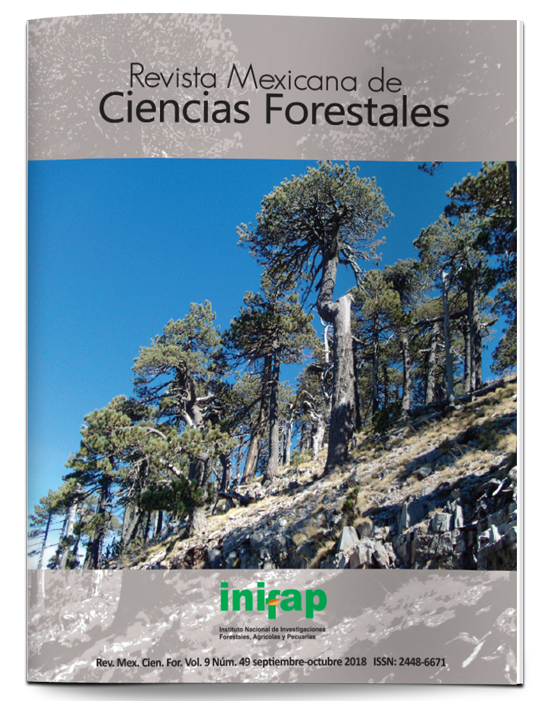Physicochemical characterization of a Calcisol under different land -use systems in Northeastern Mexico
DOI:
https://doi.org/10.29298/rmcf.v9i49.153Keywords:
Calcisol, physicochemical characteristics, organic matter, Tamaulipan thornscrub, Northeastern Mexico, land -use systemsAbstract
Changes in land use cause variations in the physicochemical characteristics of soil. The present study aims to quantify the changes in the physicochemical characteristics of a Calcisol in three land uses in the Northeast of Mexico: Native Vegetation Area (AVN), Cropland Area (AA) and Pasture Area (ASP). Four composite soil samples were taken at 0-5 and 5-30 cm depth from each land- use plot. The variables bulk density, texture, mechanical resistance to penetration, organic matter, pH and electric conductivity were determined. The analysis of variance showed differences in the organic matter with values of 4.2 % for AVN, 2.08 % for ASP and 1.19 % and for AA in the depth 0-5 cm. The texture was clay loam for AA, silty loam for ASP and loam for AVN showing differences. The soil under the three types of land -use presented low salinity (70.2 to 396.0 μS cm-1) showing differences at both depths. The soil hardness showed differences (p≤0.05) between plots. The AA showed lower values (0.78 kg cm-2), contrasting with the values obtained for ASP (2.98 kg cm-2) and AVN (3.10 kg cm-2). The pH and bulk density did not show. On the other hand, the decrease of the soil’s organic carbon in the first 5 cm depth was up to 71.6 % when cultivating an area over a period of 60 years that was originally a thornscrub. Furthermore, the abandonment of the cropland for the establishment of a grazing system for 15 years led to a re-accumulation of organic matter up to 21.2 %.
Downloads
Published
How to Cite
Issue
Section
License
The authors who publish in Revista Mexicana de Ciencias Forestales accept the following conditions:
In accordance with copyright laws, Revista Mexicana de Ciencias Forestales recognizes and respects the authors’ moral right and ownership of property rights which will be transferred to the journal for dissemination in open access.
All the texts published by Revista Mexicana de Ciencias Forestales –with no exception– are distributed under a Creative Commons License Attribution-NonCommercial 4.0 International (CC BY-NC 4.0), which allows third parties to use the publication as long as the work’s authorship and its first publication in this journal are mentioned
The author(s) can enter into independent and additional contractual agreements for the nonexclusive distribution of the version of the article published in Revista Mexicana de Ciencias Forestales (for example, include it into an institutional repository or publish it in a book) as long as it is clearly and explicitly indicated that the work was published for the first time in Revista Mexicana de Ciencias Forestales.
For all the above, the authors shall send the form of Letter-transfer of Property Rights for the first publication duly filled in and signed by the author(s). This form must be sent as a PDF file to: ciencia.forestal2@inifap.gob.mx
This work is licensed under a Creative Commons Attribution-Noncommercial 4.0 International license.







